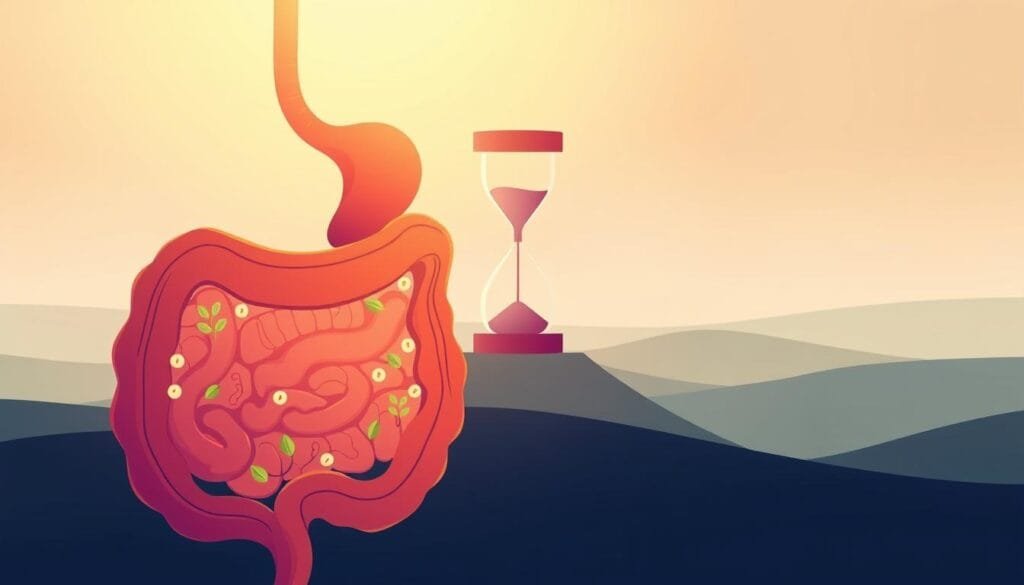Currently Empty: RM0.00
Ever wondered why some people breeze through their fasting periods while others struggle with hunger pangs? The secret might lie in a simple yet powerful nutrient—fiber. This unsung hero plays a crucial role in optimizing results during intermittent fasting, making the process smoother and more effective.
Intermittent fasting isn’t just about skipping meals. It’s a science-backed approach to improving metabolism, gut health, and even weight loss. Pairing it with the right nutrients, like fiber, can amplify these benefits. Studies show that fiber helps stabilize blood sugar, keeps hunger at bay, and supports the 100 trillion gut bacteria essential for digestion.
Wellness Concept, a trusted name in Malaysia, offers personalized guidance to help individuals integrate fasting seamlessly into their lifestyles. Their expertise ensures sustainable results—no quick fixes, just long-term wellness.
Key Takeaways
- Fiber helps stabilize hunger and blood sugar during fasting windows.
- Gut health improves with fiber, aiding digestion and metabolism.
- Science-backed strategies make fasting more effective.
- Wellness Concept provides tailored fasting guidance.
- Sustainable habits beat short-term diet trends.
Why Fiber Is a Game-Changer for Intermittent Fasting
The missing puzzle piece in successful fasting might be sitting in your pantry. Unlike restrictive diets, fasting thrives on strategic nutrition—especially the right type of fiber. It’s not just about filling your stomach; it’s about fueling your body smartly.
Soluble vs. Insoluble Fiber: What’s the Difference?
Soluble fiber dissolves in water, forming a gel that slows digestion. This feeds the gut microbiome, producing short-chain fatty acids that reduce inflammation. Think of it as a sponge, soaking up excess sugars and fats.
Insoluble fiber, on the other hand, adds bulk to stool. It keeps things moving, preventing constipation during longer fasting windows. Malaysian staples like oats and dragon fruit offer both types, making them ideal for fasting diets.
How Fiber Keeps You Full During Fasting Windows
Viscous fibers, a subtype of soluble fiber, are masters of appetite control. They form a thick gel in the stomach, delaying hunger signals. A study found they can reduce calorie intake by 23%—perfect for 16:8 fasting.
But balance is key. Sudden fiber spikes without enough water may cause bloating. Start with small portions of okra or chia seeds, and hydrate well. Your gut—and fasting stamina—will thank you.
How Fiber for Intermittent Fasting Support Works
What if the key to easier fasting lies in your gut? Research shows that certain nutrients work behind the scenes to stabilize energy and curb cravings. Here’s how they function.

The Gut-Fasting Synergy
During fasting, gut bacteria ferment dietary fiber into compounds like butyrate. This fatty acid reduces inflammation and strengthens the colon lining. A 2023 study linked high-fiber diets to lower CRP levels, a marker of inflammation.
For Malaysians, pairing kombucha with fiber-rich meals boosts probiotic synergy. This combo supports the microbiome, making fasting windows more manageable.
Blood Sugar Balance
Fiber slows carbohydrate absorption, preventing spikes in blood sugar. This stabilizes insulin levels, reducing cravings later. Resistant starch, found in green bananas, acts as a prebiotic too.
| Malaysian Breakfast | Fiber Content (g) | Impact on Fasting |
|---|---|---|
| Nasi lemak (no fiber) | 1g | Rapid hunger return |
| Oats with dragon fruit | 8g | Steady energy for 4+ hours |
Tip: Excessive insoluble fiber (e.g., bran) may irritate IBS. Start with small portions of chia seeds or okra.
Best High-Fiber Foods to Eat During Your Eating Window
Local Malaysian ingredients pack a powerful punch for staying full longer. Prioritize high-fiber foods that digest slowly, keeping hunger at bay and energy steady. From viscous fibers to resistant starches, the right choices can transform your eating window.
Top Viscous Fiber Sources for Satiety
These gel-forming fibers are champions of fullness:
- Chia seeds: Expand in liquid, providing 10g of fiber per ounce.
- Psyllium husk: A teaspoon mixed in water curbs cravings for hours.
- Winged beans: A local favorite with 5g of fiber per half-cup.
Soaking beans overnight reduces oligosaccharides, minimizing bloating. Pair tempeh with leafy greens for a gut-friendly, protein-rich meal.
Plant-Based vs. Supplements: Which Is Better?
While glucomannan supplements show weight-loss promise, whole foods offer phytonutrients absent in pills. Compare:
| Option | Pros | Cons |
|---|---|---|
| Brown rice | 3g fiber per cup, affordable | Longer cooking time |
| Fiber pills | Convenient | May interact with medications |
Tip: “Fiber-enriched” processed snacks often spike blood sugar. Stick to natural sources like dragon fruit or oats.
Wellness Concept tailors food lists to individual needs, ensuring optimal fiber intake without discomfort.
Practical Tips to Incorporate Fiber into Your Fasting Routine
Smooth fasting isn’t just about willpower—it’s about smart nutrition timing. Pairing fiber with strategic hydration supports digestive health and keeps hunger manageable. Here’s how to optimize your eating window without discomfort.
Meal Timing and Portion Strategies
Eating fiber-rich meals 3 hours before fasting begins stabilizes energy. A gradual 3-day ramp-up helps the gut adjust:
- Day 1: Add 5g fiber (e.g., ½ cup oats).
- Day 2: Increase to 10g (oats + chia seeds).
- Day 3: Target 15g (veggies + psyllium husk).
Portion control matters. Use your palm to measure nuts and a fist for cooked veggies. *Tip: Evening fiber intake improves next-day fasting stamina.*
Hydration Tips to Avoid Digestive Discomfort
Fiber absorbs water, so sip 500ml before meals to prevent bloating. Herbal teas like ginger-turmeric aid digestive health and electrolyte balance. Note these differences:
| Food | Hydration Need |
|---|---|
| Durian | Extra 300ml water |
| Jackfruit | Standard hydration |
Track intake with apps like MyFitnessPal. For Ramadan, prioritize hydrating fibers (cucumbers, coconut water) at suhoor.
Potential Side Effects and How to Avoid Them
While fiber offers many benefits, understanding potential side effects ensures a smoother fasting journey. Some people experience temporary discomfort when increasing intake. With simple adjustments, these issues can be managed effectively.
Bloating and Gas: Causes and Solutions
Sudden fiber spikes cause gas in 68% of adults. High-FODMAP foods—like onions or legumes—ferment in the gut, worsening bloating. Malaysian staples such as petai (stink beans) or durian may trigger this.
Try these fixes:
- Activated charcoal: 500mg with meals reduces gas.
- Low-FODMAP swaps: Replace cabbage with bok choy.
- Cooking methods: Pressure cooking beans cuts fermentable sugars.
When to Adjust Your Fiber Intake
Certain health conditions require careful monitoring. Diabetics should consult a doctor, as fiber affects medication absorption. Thyroid patients may need spaced-out intake to avoid interference with hormones.
| Symptom | Severity | Action |
|---|---|---|
| Mild bloating | 1–3 (scale of 5) | Reduce insoluble fiber |
| Persistent cramps | 4–5 | Seek medical advice |
Tip: Track symptoms for 3 days to identify triggers. Wellness Concept’s nutritionists specialize in tailoring plans for IBS or histamine intolerance.
Get Expert Guidance from Wellness Concept
Struggling to maintain consistency with your fasting routine? Expert guidance could be the missing link. Wellness Concept specializes in transforming fasting challenges into sustainable victories with science-backed strategies.

Tailored Programs for Every Need
Their certified coaches design plans based on individual goals and health conditions. Services include:
- Gut microbiome testing: Identify bacterial imbalances affecting digestion.
- Ramadan modules: Adjust fasting schedules for energy and hydration.
- 5-step consultations: From assessment to progress tracking.
“With their plan, I lost 32kg without starving. The Bahasa Malaysia-speaking team made it effortless.”
Start Your Journey Today
Clients with professional fasting support achieve 3x better results than self-guided attempts. Wellness Concept offers:
| Service | Benefit |
|---|---|
| Free WhatsApp assessment | Instant feedback via +60123822655 |
| Klang Valley clinics | In-person or virtual sessions |
Business hours: Mon–Fri 9:30am–6:30pm, Sat–Sun 10am–5pm. Download their fasting tracker template to begin.
Conclusion
Small changes today can lead to big health wins tomorrow. Pairing the right nutrients with intermittent fasting creates lasting results. Fiber helps manage hunger and boosts gut health, making fasting easier.
For best results, seek expert guidance. Wellness Concept tailors plans to individual needs, ensuring a sustainable lifestyle. Their team helps avoid common pitfalls like extreme fasting or improper fiber intake.
Start slow—add fiber-rich foods gradually. This prevents discomfort while maximizing health benefits. Remember, consistency beats perfection every time.
Ready to begin? Contact Wellness Concept via WhatsApp for personalized advice. Discover more about the health benefits of fiber on their blog.
As the Malay proverb goes: “Sedikit-sedikit, lama-lama jadi bukit.” (Little by little, a hill is formed.)
FAQ
What’s the difference between soluble and insoluble fiber?
Soluble fiber dissolves in water, forming a gel-like substance that slows digestion and helps stabilize blood sugar. Insoluble fiber adds bulk to stool, promoting regularity and gut health. Both types play a role in fasting success.
How does fiber help with hunger during fasting?
High-fiber foods expand in the stomach, creating a feeling of fullness. They also slow digestion, helping to curb cravings and maintain energy levels between meals.
Can fiber improve gut health while fasting?
Yes! It feeds beneficial gut bacteria, reducing inflammation and supporting digestion. A healthy microbiome may also enhance nutrient absorption during eating windows.
What are the best high-fiber foods for intermittent fasting?
Focus on whole foods like chia seeds, lentils, avocados, and berries. These provide nutrients along with fiber, keeping meals balanced and satisfying.
Should I take fiber supplements or stick to whole foods?
Whole foods are ideal because they offer additional vitamins and minerals. However, supplements like psyllium husk can be useful if dietary intake falls short.
How can I avoid bloating when increasing fiber intake?
Start slowly, drink plenty of water, and pair fiber with probiotics like yogurt or fermented foods. This helps the digestive system adjust without discomfort.
When should I adjust my fiber intake?
If you experience persistent bloating, constipation, or energy crashes, reassess portion sizes and hydration. Everyone’s tolerance varies, so listen to your body.
Can fiber help with weight loss during intermittent fasting?
Yes! By promoting fullness and stabilizing blood sugar, it may reduce overall calorie intake. Combined with fasting, this supports sustainable fat loss.



